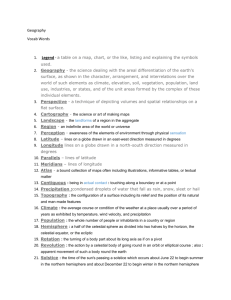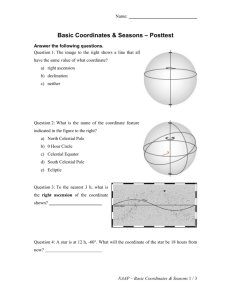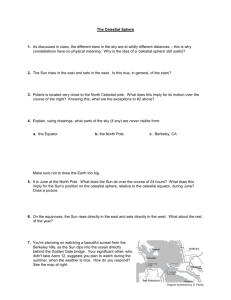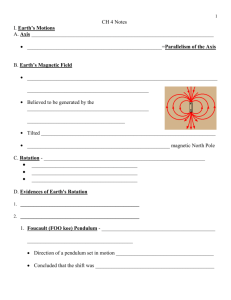Astronomical Coordinates & Seasons Explained
advertisement
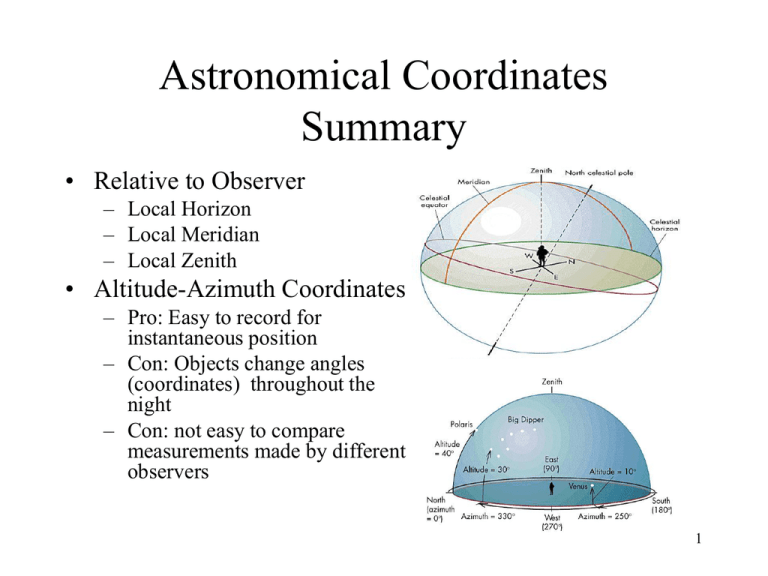
Astronomical Coordinates Summary • Relative to Observer – Local Horizon – Local Meridian – Local Zenith • Altitude-Azimuth Coordinates – Pro: Easy to record for instantaneous position – Con: Objects change angles (coordinates) throughout the night – Con: not easy to compare measurements made by different observers 1 Ancient Alt.-Az. Observatory • Chankillo, Peru • 2300 years old • Marks positions of sunrise throughout the year 2 Last Class Summary: Astronomical Coordinates • Fixed to rotating Earth – Celestial Equator – Right Ascension: Measure from Vernal (March) Equinox – Declination: measure from Celestial Equator Celestial Coordinates – Pro: stars have fixed coordinates – Pro: easy to compare measurements made by different observers – Note: Sun changes celestial coordinates throught the year as it follows the ecliptic through the Zodiac – Note: Require a clock at each observatory for coordinate system reference. 3 Time of the Seasons • We have seasons because of the tilt of the Earth’s axis. • The Ecliptic appears tilted 23.5° from the Celestial Equator because Earth’s axis is tilted 23.5° from the vertical to the plane of its orbit • Because of this tilt the Sun appears half the year North of the Equator and half the year South of the Equator • The seasons are defined based on the location of the Sun compared to the Celestial Equator 4 Summer On the first day of Summer: – The Sun is at its farthest distance North of the Celestial Equator (23.5° N declination). The is known as the Summer Solstice. – The Northern Hemisphere is tilted towards the Sun & we experience the longest day of the year (about June 21). – The Southern Hemisphere is tilted away from the Sun. This is the beginning of Winter and the shortest day of the year there. – Sun rise and sets at its most northerly 5 6 Why it’s hotter in the Summer and colder in the Winter At the summer solstice, the North gets more direct sunlight and more hours of sunlight. At the same time it is winter in the South (less direct sunlight, fewer hours of daylight). 7 In the winter months the Sun is lower in the sky for fewer hours and the sunlight is spread over a larger area. 8 “But I thought the reason it was hotter in the summer was because the Earth was closer to the Sun in the Summer.” • If this were true then why is the Earth closest to the Sun in January and farthest from the Sun in July? and • Why does the Southern Hemisphere have seasons that are opposite that in the Northern Hemisphere? 9 Winter On the first day of Winter: – The Sun is at its farthest South of the Celestial Equator (23.5° S declination). This is known as the Winter Solstice. – The Northern Hemisphere is tilted away from the Sun & we experience the shortest day of the year (about December 21). – The Southern Hemisphere is tilted towards the Sun. This is the beginning of Summer and is the longest day of the year there. – Sun rise and set is at its most southerly. 10 Spring and Autumn • The Sun crosses the Celestial Equator heading North on the first day of Spring (the Vernal Equinox, about March 21). • It crosses the Celestial Equator again heading South on the first day of Autumn (the Autumnal Equinox, about September 21). • In both the Northern and Southern Hemisphere days and nights are of equal length 11 Seasons Interactives • Seasons Interactive I - McGraw Hill • Seasons Interactive II - University of Nebraska Lincoln (UNL) • Sun Motion – UNL • Seasons Interactive III - Iowa State 12 Summary – The Seasons • The rotation of the Earth on its axis determines the length of the day • The orbit of the Earth around the Sun (revolution) determines the length of the year • The tilt of the Earth with respect to the ecliptic causes the seasons. 13 Summary - Equinoxes • The two equinoxes occur when the Sun crosses the Celestial Equator – In March, as the Sun is heading North, and – In September, as the Sun is heading South • Equinox means “equal night” – Length of night is the same as the length of daylight for the equinoxes • The Sun will rise due East and set due West. • For an observer on the Earth’s equator – The sun will be at the observer’s zenith at local noon. • For an observer on a pole: the Sun circles the observer on the horizon…16 hours from half-to-all or half-to-gone. 14 Equinoxes On equator, lat. = 0 At lat. = 20 At lat. = 50 At pole lat. = +90 Summary - Solstices • The two solstices occur when the Sun reaches its extreme North or South positions in the sky. – December Solstice: farthest South – June Solstice: farthest North 16 Solar Altitude Variation Over Six Months 17 Analemma • Earth's axis is tilted 23.5 degrees • Earth's orbit is elliptical, not circular 18 Analemma Interactive • http://www.analemma.com/SunGraph/index.html • APOD - Analemma Movie over New Jersey 19 Analemma for Greenwich, England Latitude +51 20
